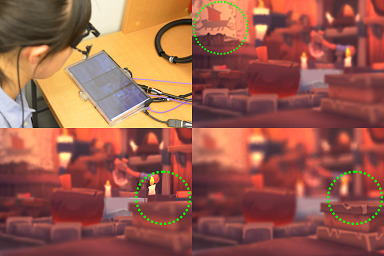Perceptually-Guided Foveation for Light Field Displays

A variety of applications such as virtual reality and immersive cinema require high image quality, low rendering latency, and consistent depth cues. 4D light field displays support focus accommodation, but are more costly to render than 2D images, resulting in higher latency. The human visual system can resolve higher spatial frequencies in the fovea than in the periphery. This property has been harnessed by recent 2D foveated rendering methods to reduce computation cost while maintaining perceptual quality. Inspired by this, we present foveated 4D light fields by investigating their effects on 3D depth perception. Based on our psychophysical experiments and theoretical analysis on visual and display bandwidths, we formulate a content-adaptive importance model in the 4D ray space. We verify our method by building a prototype light field display that can render only 16%-30% rays without compromising perceptual quality.
Publication Date
Published in
Uploaded Files
Copyright
Copyright by the Association for Computing Machinery, Inc. Permission to make digital or hard copies of part or all of this work for personal or classroom use is granted without fee provided that copies are not made or distributed for profit or commercial advantage and that copies bear this notice and the full citation on the first page. Copyrights for components of this work owned by others than ACM must be honored. Abstracting with credit is permitted. To copy otherwise, to republish, to post on servers, or to redistribute to lists, requires prior specific permission and/or a fee. Request permissions from Publications Dept, ACM Inc., fax +1 (212) 869-0481, or permissions@acm.org. The definitive version of this paper can be found at ACM's Digital Library http://www.acm.org/dl/.
